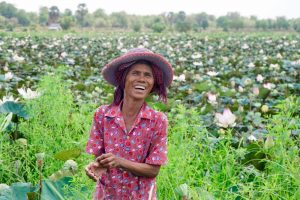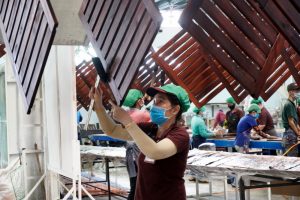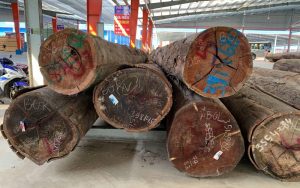We are back from the field this week after ten days traveling in the Mekong Basin with our team.
Hundreds of millions of people live along the Mekong, and the rate of change in Vietnam, Cambodia, and Laos was stunning. The forces of development are ever-present in demands for raw materials and the construction of dozens of new dams, leading to increased deforestation, irreversible damage to the river, and impacts on the livelihoods of millions.
But there is also another way forward for the Mekong Region.
First, a bit of history. In the summer of 1998, reeling from Yangtze River floods that killed thousands and left an estimated 14 million people homeless, Chinese officials banned logging in the remaining forests in the Yangtze basin and around every other major river in 13 provinces. The floods, officials admitted, were largely man-made, caused by decades of unchecked forest loss. Over the next 20 years, China’s National Forest Protection Program protected standing forests and restored others, culminating in a full ban on logging in all of China’s natural forests in 2017.
This had unexpected and far-reaching consequences: the global map of timber trade flows was redrawn. China became a vacuum for imported timber. Wood arrived in great volumes from the Russian Far East, Southeast Asia, Sub-Saharan Africa, and Pacific Islands: countries with weak governance, meaning that much of that timber was likely harvested illegally or unsustainably. At the time, China was already becoming the “world’s wood-shop,” mass-producing furniture and other goods such as flooring. This meant timber imports were turned into products for companies like Lumber Liquidators, then exported to Europe and the United States – or consumed domestically by China’s middle class, which grew at breakneck speed.

Two decades later, the story is repeating itself elsewhere in the neighborhood.
Like China, Vietnam has also banned logging in its forests. The country’s once-abundant forests, scourged by the Vietnam War and decades of over-harvesting, are now regenerating at a rate of 2 percent each year.
At the same time, however, Vietnam’s wood product industry has grown rapidly, becoming a major competitor to China. With its own forests off-limits, Vietnamese industry turned to the rest of the world – importing nearly $2 billion in wood products in 2018.
Today Vietnam is one of the largest importers of tropical hardwood in the world. Roughly half of this wood comes from countries which often lack the capacity to effectively govern their resources, let alone ensure the sustainability and legality, of their forest harvests.
The Government of Vietnam has woken up to the need to address the potential for illegal imports, most significantly by developing a Voluntary Partnership Agreement under the EU’s Forest Law Enforcement, Governance, and Trade process (FLEGT-VPA) that will ensure the trade in exclusively legal timber.

Vietnamese industry players are acting even faster.
Illegally sourced wood arriving in Vietnam’s ports presents an unwelcome risk to their wood products industry. The threat of losing access to profitable markets in the EU, United States, and other countries excluding illegal timber looms large, as does potential international media coverage that Vietnam’s penchant for protecting its own forests is causing rampant deforestation and human rights abuses in other countries. For export-oriented companies, being able to demonstrate that their wood comes from legal or sustainable sources is increasingly the price of doing business. In fact, Vietnamese industry leaders see this as a way to gain an edge over the Chinese competition and are working to build a positive global reputation for “Vietnamese good wood.”
While logging in natural forests is outlawed, plantations are alive and well: plantations managed by smallholder farmers supply around two-thirds of the country’s domestically grown wood. Leading companies are working with these smallholders to make the shift to verified legal and sustainable supply chains.
For example, Scansia Pacific specializes in processing wood products for IKEA. It was the first company in Vietnam to help smallholders get FSC certification for their small plots of acacia trees, which allows them to sell to major buyers with certification requirements, including IKEA.
Another early leader is trading company TAVICO, one of Vietnam’s largest timber importers. TAVICO collaborates with Vietnamese artisans who have typically used raw wood materials imported from Cambodia or Laos, which are often illegally harvested from national parks and protected areas, assisting them to replace illegally sourced wood with legal, sustainable material. TAVICO also purchases finished goods from small enterprises to help them gain access to larger export markets with better prices.

Forest Trends works with companies like Scansia Pacific and TAVICO, as well as with the country’s top timber industry associations, to expand sustainable business models that directly benefit local smallholders and artisans.
We complement this approach with efforts at the national level, engaging industry and government to dismantle constraints to innovation such as policy barriers that make it difficult for Vietnamese farmers to get FSC-certified and meet legality requirements. We are directly advising the development of a Timber Legality Assurance System under the FLEGT-VPA, which would put in place new laws and regulations to level the playing field, discouraging companies to undercut competitors’ prices with cheap, illegally sourced wood materials.
History is not going to repeat itself in Vietnam.
We see great potential to replicate Vietnam’s model for sustainable wood supply chains in nearby Cambodia and Laos. Another opportunity lies in assisting alternative forest-based economic models, such as agroforestry and ecotourism enterprises. Demand for clean, legal supply chains and sustainable investment models will keep growing – and Vietnam can become its own model for other Mekong countries and beyond.
Viewpoints showcases expert analysis and commentary from the Forest Trends team.
Connect with us on Facebook and Twitter to follow our latest work.
